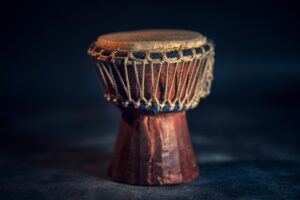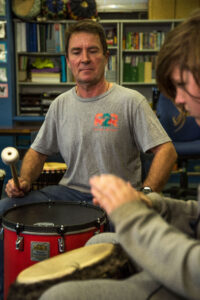By Simon Faulkner
Drumming as a tool in therapeutic practice is getting increasing attention as the body of research supporting its positive impact mounts. There are now over 20 peer reviewed studies bearing witness to the power of this medium to positively impact people’s lives (1). This contemporary use of rhythmic music, and drumming in particular, in our healing practices extends an unbroken line of knowledge dating back to our earliest human communities.
At the same time there has been a growing interest in the somatic or body orientated, therapies, particularly in relation to the treatment of trauma. This has coincided with an increasing awareness of the limitations of cognitive or ‘talk based’ approaches. Advances in neuroscience have shown that the language processing regions of the brain, Broca’s area, shut down in response to severe trauma, often making these traditional therapeutic approaches unworkable (2). Additionally, there is a significant danger of re-traumatisation when people are pushed too early into discussing the circumstances and emotions of the traumatic event itself (3).
There are a range of different approaches to working with the body including somatic psychotherapy, somatic psychology, sensorimotor psychotherapy (Pat Ogden) and Somatic Experiencing™ (Peter Levine). As well as dance & massage therapies. All of these share an understanding that our emotional responses to trauma and other experiences, such as our common fears and anxieties, play out through the body as well as the mind, and in fact, that there is a self-perpetuating link between the two (4). The modern lexicon is full of phrases that speak to this link – ‘gut wrenching’, ‘twisted up inside’ ‘my stomach dropped’ etc. Research has shown a clear link between trauma and a wide range of physical symptoms, including gut complaints like irritable bowel syndrome, and other issues such as chronic fatigue, and fibromyalgia (5).
Our bodies hold on to past traumas, which are reflected in our body language, posture, and expressions. We brace for threat, constricting our bodies and sending signals to the brain that the threat persists. These uncomfortable, visceral feelings are relayed back to the brain via the vagus nerve and are party to a chain of reaction that leads both regions to become over-reactive to each other and in a state of constant arousal. In order to cope, many people shut down those areas of the brain that transmit these bodily feelings, repressing them and consequently ensuring they remain trapped within, long past their use-by date (6). This form of denial prevents us from healing.
This bidirectional communication between the brain and the gastrointestinal tract, the so – called “brain–gut axis,” is based on a complex system, with the vagus nerve at its centre. The vagus nerve carries an extensive range of signals from the digestive system and organs to the brain and vice versa. It is responsible for the regulation of internal organ functions, such as digestion, heart rate, and respiratory rate. It is also responsible for monitoring physiological homeostasis and connecting the emotional and cognitive areas of the brain with peripheral functions, such as immune activation (7). Many mental health conditions are characterised by underlying inflammatory immune responses and recent studies of drumming therapies with people suffering from depression and other mental health conditions have shown significant reductions in these immune response activation markers (8).
Somatic therapies facilitate the resolution of trauma and its associated physical and psychological markers by increasing our awareness and acceptance of our bodily responses and finding ways to discharge the tension held within. The use of the drum can serve the practitioner in multiple ways in working through these elements with the client.
Specifically, the drum provides a vehicle for the release of trapped feelings. Where a cognitive therapist may ask “How did that feel?” and potentially elicit no response or one that is open to interpretation. An experiential practitioner can use the drum – “Would you like to play how that felt”. The drum provides a far greater freedom, and a much safer alternative to the narrow range we have for describing these complex sensations through language.
The drum is a powerful grounding tool with the resonance activated by the player seeping from the drum, through the body and connecting and aligning to the rhythms of the natural world. Both mindfulness and grounding exercises can be given additional efficacy through the use of the drum, usually played at a tempo that replicates the mothers heart-beat at rest; 60-80 beats per minute. This tempo is associated with the calm and security that accompanies our time in the womb and is also believed to be the primary stimuli under which the areas of the brain responsible for our stress response are formed.
As trauma researcher Dr Bruce Perry states: “One of the most powerful sets of associations created in utero is the association between patterned repetitive rhythmic activity from maternal heart rate, and all the neural patterns of activity associated with not being hungry, not been thirsty, and feeling ‘safe’ (in the womb). Patterned, repetitive, rhythmic somatosensory activity… elicits a sensation of safety. Rhythm is regulating. All cultures have some form of patterned, repetitive rhythmic activity as part of their healing and mourning rituals — dancing, drumming, and swaying” (9).
As Dr. Perry states, these are not new techniques but date from our earliest healing practices and are found across all cultures. Traditions of chanting in Buddhist and Christian religions utilise a similar principle. Lower frequency vibrations, resonate through the body, particularly in the lower stomach and diaphragm region, and have been found to have a direct effect on the parasympathetic nervous system; slowing breathing and activating the vagus nerve (10). Lower frequency rhythms, played on the Bass note of the drum, are known to resonate with the body’s own physiology, and positively impact primal functions such as heart rate, respiratory rate and blood pressure. One recent study addressing children with habitual states of fear showed that rhythm interventions, at 60-beats per minute (bpm), can regulate and induce systemic pacing, reduce repetitive anxiety behaviours and enable focus and calm (11).
Somatic therapies and drumming sit side-by-side as evidence-based approaches to supporting people through the release of trauma held in the body. And in particular, offer an alternative medium to some of the more hazardous treatment regimes. Our biological responses need to remain fluid and these therapies assist us in loosening the rigidity of those maladaptive responses that continue to allow the trauma and pain to dominate people’s lives.
Simon Faulkner, BSocSc. (Psychology & Addiction), MCouns., is a leading practitioner in the design and delivery of evidence-based interventions utilising rhythmic music to assist with social and emotional learning and recovery from trauma. He is the author of the book ‘Rhythm to Recovery’ and has contributed to over a dozen published papers and research studies on rhythm-based interventions within therapeutic and educational settings
Simon has worked with a broad range of clients including young people ‘at risk’, people dealing with drug and alcohol addiction, mental health challenges and developmental disorders, refugees working through trauma and prisoners.
When working in regional Australia with Aboriginal people Simon conceived the multi-award-winning DRUMBEAT intervention as a means to engage clients who were averse to talk-based therapies. He later went on to design the world’s first rhythm-based computer game for the development of social and emotional skills – DRUMBEAT Quest — both programs are used by health and education services in countries across the world.
Simon has extensive experience working cross culturally and has delivered therapeutic interventions and training programs to Aboriginal and Torres Strait Islander communities across Australia as well as 1st Nations communities in both the USA and Canada. Simon has also worked closely with trauma services supporting refugee populations from a wide range of backgrounds.
Email: simon@rhythm2recovery.com
Ph +61 0429 038 380
www.rhythm2recovery.com
Notes:
1 Rhythm Research & Resources https://www.rhythmresearchresources.net/
2 Van der Kolk, B. (2015). The body keeps the score: Brain, Mind & Body in the healing of trauma, Penguin.
3 Kezelman, C., & Stravropolous, P. (2019). Practice guidelines for clinical treatment of complex trauma, Blue Knot Foundation https://www.blueknot.org.au/Resources/Publications/Practice-Guidelines/Practice-Guidelines-2019
4 Levine, P. (1997). Waking the tiger: Healing trauma. North Atlantic Books.
5 Stam, R., Akkermans, L. M., & Wiegant, V. M. (1997). Trauma and the gut: interactions between stressful experience and intest inal function. Gut, 40(6), 704–709. https://doi.org/10.1136/gut.40.6.704
6 Van der Kolk, B. (2015). The body keeps the score: Brain, Mind & Body in the healing of trauma, Penguin.7 Carabotti M, Scirocco A, Maselli MA, Severi C. (2015).The gut-brain axis: interactions between enteric microbiota, central and enteric nervous systems. Annals of Gastroenterol 28:203–9
7 Carabotti M, Scirocco A, Maselli MA, Severi C. (2015).The gut-brain axis: interactions between enteric microbiota, central and enteric nervous systems. Annals of Gastroenterol 28:203–9
8 Fancourt, D., Perkins, R., Ascenso, S., Carvahlo, L.A., Steptoe, A., and Williamon, A. (2016). Effects of Group Drumming Interventions on Anxiety, Depression, Social Resilience and Inflammatory Immune Response among Mental Health Service Users . PLoS ONE 11(3): e0151136. https://doi.org/10.1371/journal.pone.0151136
9 Perry, B.D. and Hambrick, E. (2008), “The Neurosequential Model of Therapeutics (NMT),” Reclaiming Children and Youth, 17 (3) 38-43
10 Perry, G., Polito, V., & Thompson, W. (2016). Chanting Meditation Improves Mood and Social Cohesion. Proceedings of the 14th International Conference on Music Perception and Cognition.
11 Berger, D.S. (2011). Pilot study investigating the efficacy of tempo-specific rhythm interventions in music-based treatment addressing hyper-arousal, anxiety, system pacing and redirection from fight or flight Fear behaviours in children with ASD. Journal of Biomusical Engineering, 2. doi:10.4303/jbe/M110902
Photo Credit
Drum Photo by Paul Zoetemeijer on Unsplash








